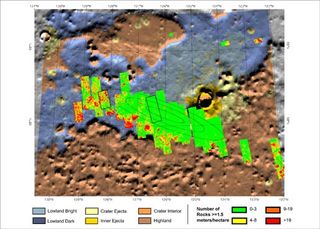Arctic Plains of Mars Await Robot's Sunday Landing

When NASA?sPhoenix Mars Lander sets down in the Martian arctic on Sunday, it will open anew, icy frontier for scientists back on Earth.
Phoenix, astationary lander set to make a plannedMay 25 descent to the Martian surface, is going to where no probe has gonebefore - the northern plains of Vastitas Borealis on Mars.
"Ten yearsago, you wouldn't have chosen this spot at all because it looks just like everyother part of Mars,? said Phoenix principal investigator Peter Smith of theUniversity of Arizona. ?A lot of the features aren't even named up there."
But it?sthe promise of whatlies beneath the frozen surface features, signs of untouched Martian waterice first spotted by orbiters in 2002, which spurred NASA engineers andresearchers to launch the $420 million Phoenix last August.
Wieldingits robotic arm like a backhoe, Phoenix is designed to dig down in to theMartian soil to collect water ice samples. It will feed them into small onboardovens and beakers to determine if its landing site may have once been habitablefor microbial life.
?We believethat the ice is somewhere between 4 and 6 centimeters (1.5 to 2.3 inches) belowthe surface,? Phoenix deputy principal investigator Deborah Bass of NASA?s JetPropulsion Laboratory (JPL) told SPACE.com. ?It?s not going to be iceskating rink-pure, white, shiny ice. It?s going to be permafrost - dust, dirtand ice all mixed together.?
Only oneNASA spacecraft - the ill-fated Mars Polar Lander - has ever targeted a polarregion of Mars for study, but that spacecraft crashed just before landing nearthe planet?s south pole in December 1999. NASA?s past successful Mars landers,the two Viking probes of the 1970s and ?80s, and the hardy Spirit andOpportunity rovers that still explore the Martian surface today, set down nearthe planet?s equatorial regions.
Get the Space.com Newsletter
Breaking space news, the latest updates on rocket launches, skywatching events and more!
The historyof Earth?s own climate change and the building blocks of life are preserved inthe ices near the Arctic Sea, Smith said during a Thursday mission briefing atthe Pasadena, Calif.-based JPL.
?We?rewondering if this is true on Mars,? he added.
Phoenix?ssecond choice
Phoenix?s targetedlanding zone lies within an ellipse about 50 miles (80 km) long and 12.4miles (20 km) wide, with the bull?s eye sitting in a broad, shallow valley some800 feet (250 meters) deep.
It?s ratherchilly, with the average temperature expected to range between minus 110 to 28degrees Fahrenheit (minus 73 to minus 33 Celsius) during Phoenix?s primarysix-month mission. The probe is landing during the late Martian spring at itstarget site to take advantage of long, sunlit days for its solar arrays.
But thelanding site, known as Region D, was not the Phoenix mission team?s firstchoice. It was selected only after high-resolution images from NASA?s MarsReconnaissance Orbiter spotted fields of large boulders that could topple Phoenix during landing in 2006.
"Ithad to be safe, there had to be ice,? Smith told SPACE.com of the landingsite selection. ?We wanted some sort of surface features that showed therewas ice so we weren't just going by other measurements, and those are thepolygons that we see, which are the same as you see in the Arctic and Antarctic[on Earth]."
Polygonsare crack features created by changes in subsurface ice, he added. Phoenix?sRegion D has those features in spades.
?What wesee is a mottled terrain, caused by ice expanding and contracting underneaththe soil, and it shapes the surface,? Smith said Thursday.
Of keyinterest is whether the Martian soil will contain leftover salts fromevaporated liquid water, which Mars researchers have long held as a basicingredient for life, in the relatively recent past, Smith said. TheSpirit and Opportunity rovers have found solid evidence that liquid water oncesoaked regions of the Martian equator in the ancient past, he added.
Butevidence of recent liquid water near the Martian north pole, he added, would bea boon for researchers studying the planet?s water history, as well as for futuremissions designed specifically to seek out signs of life.
?We aregoing in blind into the northern plains,? Smith said. ?So we are just looking forevidence that it was habitable.?
NASA's will broadcast the Phoenix Mars Lander?s red planet arrival live on NASATV, with the next mission briefing set for 3:00 p.m. EDT (1900 GMT) onSaturday, May 24. Clickhere for SPACE.com's Phoenix mission coverage and a linkto NASA TV.
SPACE.comSenior Writer Andrea Thompson contributed to this story from Pasadena,California.
- Video: The Nail-Biting Landing of Phoenix on Mars
- Images: Phoenix's Landing on Mars
- The Top 10 Martian Landings of All Time
Join our Space Forums to keep talking space on the latest missions, night sky and more! And if you have a news tip, correction or comment, let us know at: community@space.com.

Tariq is the Editor-in-Chief of Space.com and joined the team in 2001, first as an intern and staff writer, and later as an editor. He covers human spaceflight, exploration and space science, as well as skywatching and entertainment. He became Space.com's Managing Editor in 2009 and Editor-in-Chief in 2019. Before joining Space.com, Tariq was a staff reporter for The Los Angeles Times covering education and city beats in La Habra, Fullerton and Huntington Beach. In October 2022, Tariq received the Harry Kolcum Award for excellence in space reporting from the National Space Club Florida Committee. He is also an Eagle Scout (yes, he has the Space Exploration merit badge) and went to Space Camp four times as a kid and a fifth time as an adult. He has journalism degrees from the University of Southern California and New York University. You can find Tariq at Space.com and as the co-host to the This Week In Space podcast with space historian Rod Pyle on the TWiT network. To see his latest project, you can follow Tariq on Twitter @tariqjmalik.
